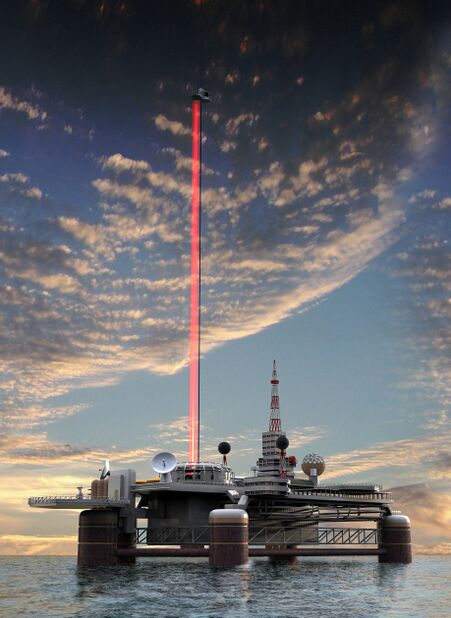Main Page: Difference between revisions
m (file name tweak) |
m (change image with to fix thumbnail missing error) |
||
| Line 1: | Line 1: | ||
__NOTOC__ | __NOTOC__ | ||
[[File:Se01_print1_ntx.JPG|right| | [[File:Se01_print1_ntx.JPG|right| 451 px]] | ||
This wiki is intended to be a repository of information and a baseline for [[About| research]] of the space elevator, a project with a back-of-the-envelope launch cost of [[SpaceElevatorCost| $6 billion dollars]]. | This wiki is intended to be a repository of information and a baseline for [[About| research]] of the space elevator, a project with a back-of-the-envelope launch cost of [[SpaceElevatorCost| $6 billion dollars]]. | ||
Revision as of 20:37, 24 January 2019

This wiki is intended to be a repository of information and a baseline for research of the space elevator, a project with a back-of-the-envelope launch cost of $6 billion dollars.
A space elevator will be about 100 times cheaper per pound than rockets because it has momentum transfer through a mechanical structure. Rockets must carry fuel for the payload, and then even more to accelerate that fuel. There are other potential possibilities besides the space elevator, but fans of space colonization need to push for something more efficient and safer than rockets. As an example, the Lauch Loop becomes much easier to build with a tether hanging down to 50KM.
Here is a paper explaining how we could build one in less than 7 years.
If you are interested in working on software for the space elevator, you can be very helpful to this effort.
If you have done some research on the SE you'd like to archive and tell others about, please go here and fill out a section. (This site gets about 2,000 visitors per month.)
Latest news
An article was published in Ars Technica about recent progress in carbon nanotubes for commercial use.
Keith Lofstrom, of the Lauch Loop fame, has written a very interesting paper analyzing the baseline Space Elevator designs and identifying challenges and coming up with some great suggestions. He also proposes multiple stages, multiple climbers, a pulley for the first stage, and some ideas on how to get to GEO in just 1 day. A few of these suggestions should probably be saved for a "version 2" of the elevator, but it's a must-read. He also wrote a paper about acoustic wave-powered climbers.
Giorgi Lobzhanidze has written a paper explaining how to remove space debris.
Giorgi has also written a paper explaining the space catapult, a method of launching material into deep space. This could also be used to launch cargo to Mars.
In March 2013 Markus Landgraf of the European Space Agency reported at TEDx Rhein Main in Offenbach, Germany about the prospects of a space elevator:
Here is a movie that will discuss how we can build a space elevator in 10 years, containing interviews with Brad Edwards and Dave Lang. Here is the teaser trailer:
Giorgi Lobzhanidze has researched how the Space Elevator can allow tourists to jump from space.
Sourabh Kaushal has written a paper on challenges in building a space elevator. He claims it will take hundreds of years to make the nanotubes, but he doesn't realize that with money, the production could be cranked up dramatically.
Giorgi Lobzhanidze has done an excellent study of space debris.
Markus Landgraf has undertaken a recent CNT literature review.
Ben Shelef's Space Solar Power proposal is added.
Dave Lang's deployment work is online.
(This is a bad deployment showing what happens with no compensating control interventions by the satellites at either end of the ribbon. We have to have lots of failures in simulations to have success in real life!)
Brad Edward's presentation on manned travel up the elevator is uploaded.
GTOSS source code is now publicly available.
News archive.
Wiki Index
Baseline space elevator design:
|
Major Space Elevator Design Challenges:
|
|
Archive of detailed work:
|
Simulation software:
|
|
Activities of Individuals:
|
|
| Open Work Space: |
|
| Space Elevator in Fiction: |
|
Meta
Account creation is disabled to stop spammers. Email keithcu@gmail.com if you'd like one.
Archive of uploaded files that need categorization: Special:Imagelist